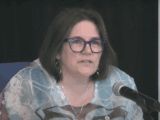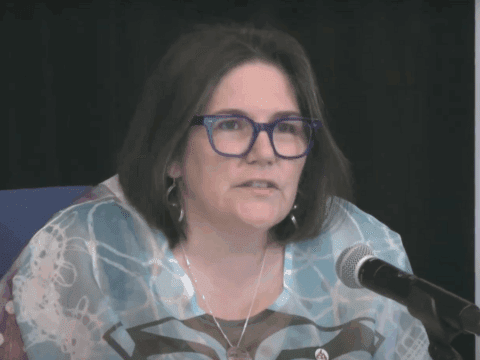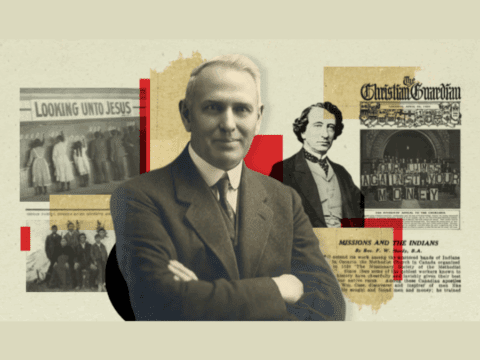How do you grow a church? It’s a problem that has vexed the leaders of organized religion in Canada for decades. In the last few years, it has been said that the answer lies with the CEOs. No, not the corporate bigwigs: CEO is short for Christmas and Easter only — those Christians who attend church only on special occasions. Not everyone buys this theory.
The debate has brought to prominence the research of Prof. Reginald Bibby, a sociologist of religion at the University of Lethbridge. Most of his research results have not been comforting. Since 1975, Bibby has surveyed Canadians at five-year intervals about their religious beliefs and practices. In book after book, Bibby has observed and reported the decline in church membership with such dreary consistency that he earned himself the sobriquet “Bad News Bibby.”
But in 2002, Bibby performed a breathtaking about-face. In Restless Gods: The Renaissance of Religion in Canada, as the subtitle announces, Bibby predicted a resurgence in active church membership, not a decline. Protestants got special mention in a spin-off newspaper article entitled “The Comeback of Organized Religion in Canada.”
“Mainstream Protestantism,” Bibby wrote definitively, “is finally showing signs of awakening from a 40-year slumber.” He said he had the numbers to prove it. Fast-forward to 2008. One sociologist giveth, another taketh away. Joel Thiessen, like Bibby a sociologist of religion, pricked Bibby’s bubble. The professor’s numbers, he reported, just don’t add up.
Thiessen is currently a PhD candidate completing his dissertation for the University of Waterloo while teaching in the sociology department of Ambrose University College in Calgary. Though relatively new to the academic profession, Thiessen is smart, thoughtful and articulate. He is intimately familiar with religious culture. His father is a Baptist minister, and Thiessen is an active member of the Church of the Nazarene in Calgary. He is also well tuned to the generation of Canadians who have chosen in droves not to participate in organized religion. At 28, he wears his hair spiked and has one ear pierced. He’s an accomplished drummer with a penchant for bands like Cold Play and U2, jazz musician Buddy Rich, and religious music. Thiessen might well have made a career as a musician, but instead opted for church and college.
Thiessen’s first contact with Bibby was as an undergraduate. Bibby was a must-read for any student of religion in Canada, “a voice of great authority, arguably the pre-eminent student of religious practice in Canada,” he says. From the start, though, Thiessen was a skeptic. “I read Restless Gods for a course in culture and religion in Canada,” he says, “and it just didn’t resonate with my personal experience.”
The sticking point was precisely Bibby’s famous projected renaissance. Thiessen poked about in the process that led to the optimistic conclusion. One segment of Bibby’s survey population comprised the CEOs, folks who attend church less than monthly, often at Christmas and Easter and for weddings and funerals. In Bibby’s work, these are dubbed “inactive affiliates” (as distinguished from “active affiliates,” who attend weekly; “marginal affiliates,” who attend at least once a month; and “disaffiliates,” who don’t attend at all). To the inactive affiliates, Bibby put this question: “Would you consider the possibility of being more involved in a religious group if you found it to be worthwhile for yourself or your family? Yes? Perhaps? No?” Fifteen percent of inactives said they would consider the possibility, and 40 percent said perhaps they would consider the possibility of greater involvement, if they found it to be worthwhile.
Bibby used the quantitative research method to probe hundreds of people. Respondents were quizzed by means of mailed surveys with a strict questionnaire protocol. They had to answer by filling in the response categories provided, and the answers had to be accepted as given. There was no opportunity to quiz participants further as to what they might mean by “consider” or how likely it was that this consideration might translate into actual engagement.
Bibby combined the “yes” and “perhaps” answers to arrive at the conclusion that 55 percent, the majority of the inactives polled, might consider greater involvement in a religious group. Upon this faintly favourable 55 percent rested the prediction of a renaissance of active church membership.
There was another piece to Bibby’s thesis. Having said in Restless Gods that There was this large number of people at the edge of the church ripe to be wooed into active service, Bibby went on, in 2004, to publish a follow-up volume called Restless Churches: How Canada’s Churches Can Contribute to the Emerging Renaissance.
The book was a how-to for church leaders seeking to draw in the pool of positive-thinking inactives to bolster their declining congregations. “I look at the relationship between the church and those on the periphery of the churches as one of supply and demand,” Bibby explains, summarizing the gist of Restless Churches.
“The demand is there. The bottom line is that there is a surprisingly large pool of people who continue to say they’d be receptive to greater involvement but they thing they’re talking about is some tangible ways the church could be addressing their needs,” He says. “Churches have to make what they supply better fit the demand.” In the book, Bibby suggested making the subject of sermons more topical, providing more broadly relevant church-sponsored programs, sprucing up church decor and even updating church music in order to attract the inactive affiliates.
Churches, accordingly, sought tangible ways to address the needs of those on the sidelines, some with great vigour, enthusiasm and resources. “Bibby has certainly had an influence on how church leaders strategize, plan and allocate budgets,” says Thiessen. “When you’ve heard for years that churches have been doing a bad job of engaging the interests of ordinary Canadians and then hear some optimism, you can’t fault churches for jumping on that optimism.”
Thiessen, however, was not so ready to jump. He took a hard look around. “On a personal level, I still didn’t see this resurgence happening, either in my own church or in the lives of the people around me at my Christian college,” he says, “and it wasn’t because faith groups weren’t trying to drum up interest.”
Thiessen wanted to know what was wrong with this picture. His second encounter with Bibby was face to face. In 2004, Bibby gave a workshop at Knox United in Calgary.
Thiessen attended. “I was a third-year undergrad and never timid to ask questions,” Thiessen recalls. “I posed a few, and we went back and forth a little. But I wasn’t really satisfied with the answers. That caused me to want to investigate further.”
Indeed, further investigation of Bibby’s startling message of hope became the main thrust of Thiessen’s subsequent academic inquiries. In 2008, these bore first fruit. With colleague Lorne Dawson, Thiessen published an essay based on his work for his master’s degree. Their paper, in the journal Studies in Religion, was called “Is There a ‘Renaissance’ of Religion in Canada? A Critical Look at Bibby and Beyond.” The question was rhetorical; the answer, they concluded, was no.
“Bibby seems to be using his data rather selectively to render his renaissance thesis plausible,” they wrote. “The cumulative weight of [Bibby’s] own evidence” pointed to no such renaissance of organized religion. Moreover, the authors continued, “The credibility of [Bibby’s] proposal is undermined by some nagging problems with the way he sorts, reports and interprets his data.” They concluded, politely, “We have our doubts about Bibby’s new optimism.”
BIBBY REMAINS CONVINCED today that his thesis was sound. “Even though people have not been actively involved, the proportion who continue to identify is phenomenally high,” he says, adding, “The marginal affiliates have been the real promise for the United Church for decades.” But in a journal response to Thiessen, his tone was much less confident and categorical. “I would challenge readers to be open to the possibility that a modest renaissance of religion might be taking place,” Bibby wrote. “That is not really much to ask.”
It was a lot to ask, though. Too much, according to Thiessen. For his doctoral thesis, now in the works, Thiessen used the qualitative research method, relying on in-depth face-to-face encounters between the researcher and the respondent. Qualitative research typically involves fewer subjects, so while Bibby queried hundreds of subjects with his mail-out survey, Thiessen interviewed just 42 people, including 21 active church members and 21 less-engaged affiliates. Thanks to Bibby’s co-operation, Thiessen’s subjects included people who had previously been surveyed by Bibby (as well as some who had not).
Qualitative research permits a detailed discussion of the issues and lends nuance to the numerical results of quantitative research. With the less-engaged affiliates, Thiessen wanted to understand what the 55 percent positive result signified. Did these people have a genuine desire to be more involved in the religious group they were on the edges of? “Of the 21 less-engaged affiliates I interviewed,” he says, “only three people indicated that they definitely desire to be involved, and another two said they weren’t committed one way or another” — a far cry from 55 percent.
The next thing Thiessen did, following in Bibby’s steps, was to look in more detail at what would lead to the greater involvement of this much diminished cohort of favourably disposed inactive affiliates. “I wanted to probe Bibby’s argument that if religious groups would only adjust the ‘supply’ of religion to better match ‘demand’ — that is, change their preaching, their music style, the programs they offer — then people would come,” Thiessen explains.
“What I discovered was that for the very few people who desire to become more involved, the things that are limiting them are actually beyond the control of religious groups. For example, some of my respondents said that the people they are close to limit their involvement. One woman responded that her husband would frown on her becoming more involved.” Better music was not going to make any difference to her. “Others said they were too busy with the stresses of modern life to give up the time,” he reports. Topical sermons and new programs would have no impact on these people either.
“Essentially, what I am saying is people on the periphery of the church just aren’t interested in attending more regularly, and no matter what the church does, you’re not going to entice them,” he says. “On that basis, my advice to churches is to be very cautious as to what type of social or human resource capital you put into what you believe will grow your church.”
WHAT DOES THIS MEAN for the United Church? In 2006, after Bibby’s rosy prediction but before Thiessen’s contrarian essay, the United Church embarked on the Emerging Spirit campaign, a four-year, $10.5-million initiative. Most church members will know about this initiative, will have experienced it in their congregations, and indeed may have read about it in the pages of this magazine.
Emerging Spirit has been referred to as a profile-raising effort, but it would be disingenuous not to recognize that it was also, in part, an effort to put more people in pews. Where would they come from? A pool of people, in the 30- to 45- year-old age group, who were well disposed to the values of the church but so far not engaged. What would get them in the tent? Changes in the church designed to appeal to this particular demographic. It sounded decidedly Bibbyesque.
Rev. Keith Howard, executive director of the project, points out Bibby was not directly consulted in the decision to commit to Emerging Spirit, but acknowledges that Bibby’s renaissance thesis was well known and influential in church leadership circles. The Emerging Spirit website, for example, cites Bibby’s Restless Churches as supportive of its own independent research.
That research was done by Environics Research Group and was, like Bibby’s, quantitative research, but of a more sophisticated kind, according to Environics senior vice-president Jane Armstrong.
Bibby had declared that 55 percent of respondents loosely associated with a religious group would consider greater involvement. “Environics polled our target group, 30- to 45-year-olds not currently associated with another faith group, and asked them if they would be interested in a church that displayed attributes named by The United Church of Canada as describing who we were,” says Howard. The results seemed electrifying. Of their 618 respondents, those who “would potentially be interested in the kind of faith community the United Church is” amounted to a whopping 77 percent of the sample. Environics dubs this group the “potentials.”
“We said, ‘Wow, there’s a lot more potential than we thought,’” Howard recalls. “The whole Emerging Spirit project was based on that.”
Thiessen is a committed Christian. If he believed that pitching to outsiders would work, he’d celebrate. “As an active participant in a religious group and a teacher at a Christian University, I have a vested interest in the health of the church in Canada,” he says. But he’s also a social scientist. He wants to see facts. “One thing that would be useful,” he says, “would be to find out if Emerging Spirit had done what it set out to do. It would be helpful to see if people in the targeted bracket had actually begun to attend church because of the ads or WonderCafe,” the campaign’s website.
That information doesn’t exist. “The short answer is we just don’t have a way to track that,” says Howard. (The longer answer is that other performance measures were used to track other impacts of the project deemed more significant.) On the people-in-pews front, Howard refers to overall figures on church membership trends.
These numbers are ambiguous. In the two years since the launch of Emerging Spirit for which membership numbers have so far been tabulated, overall United Church membership has fallen by 2.67 percent in 2006 and by 2.27 percent in 2007. The good news is that the rate of membership decline is slowing. But there’s no way of knowing whether growth among 30- to 45-year-olds offset the traditional erosion.
Howard listens with polite interest to Thiessen’s point of view that Environics’ “potentials,” like Bibby’s “positive inactives,” hold out a false hope that changing the church will draw new members. “The biggest false hope is that the United Church will grow without any change,” counters Howard. “Is Thiessen saying the potential is not there?”
What Thiessen is saying is both yes and no. No, change will not draw the CEOs to the church, he says, but yes, change is necessary to keep active members coming back. “The good news in my research is that religious groups can act effectively to keep the people they already have,” Thiessen says.
His suggestions for keeping actives active are strangely akin to Bibby’s presciption for attracting inactive affiliates: update, upgrade, up beat.
Is that a strategy for growth? As the population ages, congregations will continue to shrivel. But Thiessen points to the other fundamental fact of life. People die, but people are born. Children who are born into the church will replenish and reinvigorate the church, he says, but only if their families remain enthusiastic and if the church makes the necessary changes to welcome and encourage them and nourish their connection. The key to future growth for organized religion, Thiessen believes, is a vital and vigorous youth ministry.
Can this story accommodate one more sociologist? Rev. Tom Sherwood is an adjunct professor of sociology at Carleton University, a United Church minister, and the newly appointed McGeachy Senior Scholar assigned to study the echo generation (the children of boomers) and their relationship to the church. “What the church has asked me to do is to give the church a chance to hear what this cohort is saying and perhaps experience what they are doing, even though they’ve chosen to speak and act outside the church,” says Sherwood.
Sherwood has been a longtime critic of Bibby and his methodological quirks. Bibby’s 55 percent, as well as Environics’ 77 percent, strike him as wishful thinking run rampant. “Let’s you and I go out and walk down the street and ask young adults, ‘If the church did something positive would they be more interested?’” he proposes. “If you’ve got a pleasant face, they’ll say something positive.” These percentages, he says, are so inflated as to be meaningless.
Sherwood endorses Thiessen’s youth ministry strategy, but with reservations. “Our young adults are not a mission field,” he says. “I think the church is wrong when it turns them into an ‘other,’ an object, a foreign population.” That said, “In pragmatic terms, if the church has limited finances and wants to effectively communicate Christian spirituality to a population that’s marginal to it, then yes, work within the family.”
But Sherwood has another idea that avoids statistical wrangling altogether. “In the United Church, we believe in a God who works in us and in others,” Sherwood points out. “When we say that, we say we believe that God is active in the lives of Jews and Muslims and people of no religious affiliation. The Spirit is loose, and the church has no monopoly over it. It is loose and active in the lives of young adults who refuse to affiliate with the church. I respect that. I’m impoverished by their absence from my congregational life, but if I find myself in the right places and the right conversations, my life is not impoverished.”
For Bibby and Thiessen, the primary reference point continues to be the institution of the church, Sherwood says. But is the measure of the success of the church really people in pews, or is there a more meaningful yardstick? Instead of obsessing about how to bring more people in, Sherwood says, the church might consider how to enlarge its definition of “in.”
***
This story first appeared in The United Church Observer’s November 2009 issue with the title “The fence-sitters: How real is the hope?”















